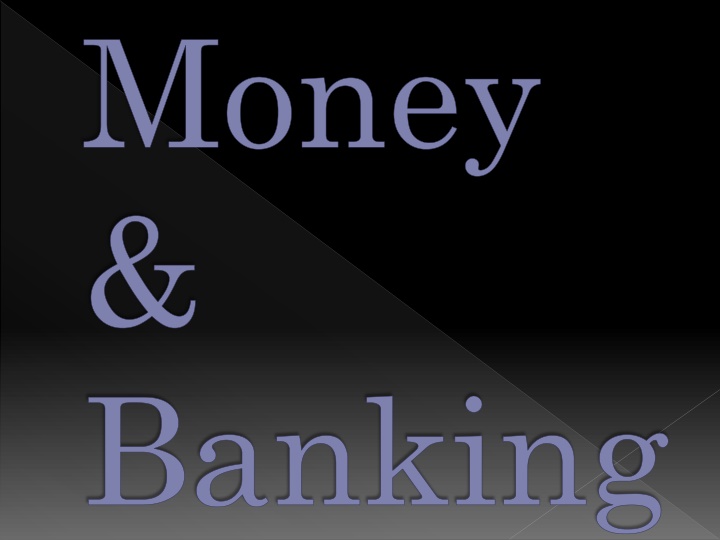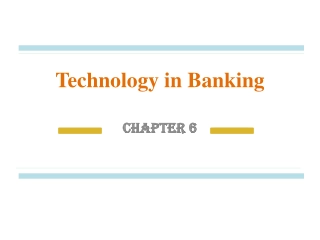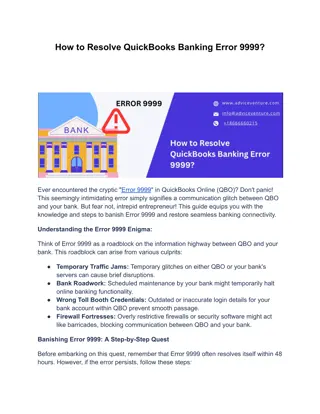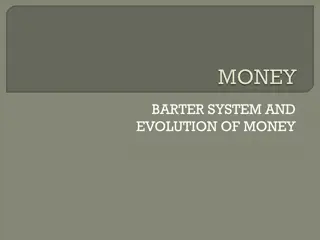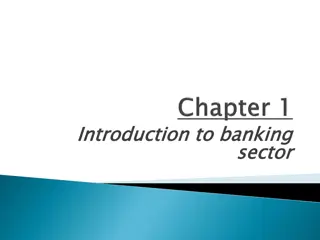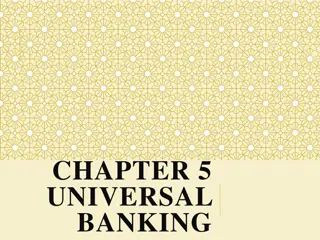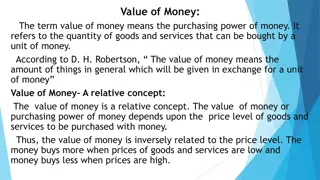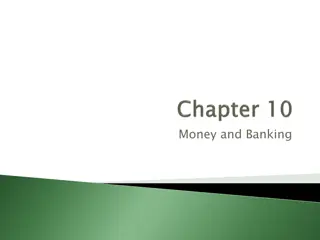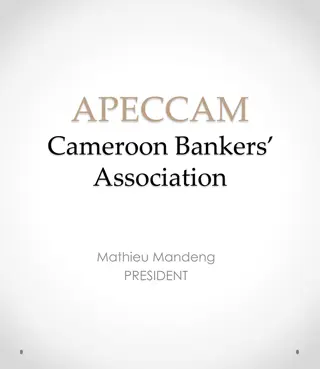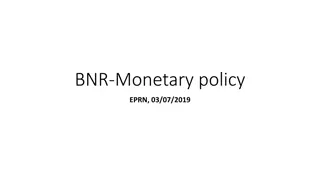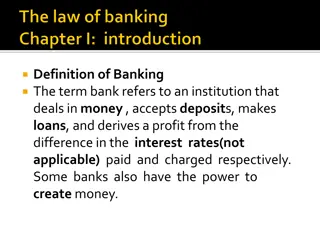Money & Banking
Money plays various roles in an economy, such as being a medium of exchange, a measure of value, and a store of wealth. Banking involves complex systems like money supply and banking ratios that ensure financial stability. Explore the functions of money, characteristics of good money, forms of money, purchase agreements, and banking ratios in this detailed overview.
Download Presentation

Please find below an Image/Link to download the presentation.
The content on the website is provided AS IS for your information and personal use only. It may not be sold, licensed, or shared on other websites without obtaining consent from the author.If you encounter any issues during the download, it is possible that the publisher has removed the file from their server.
You are allowed to download the files provided on this website for personal or commercial use, subject to the condition that they are used lawfully. All files are the property of their respective owners.
The content on the website is provided AS IS for your information and personal use only. It may not be sold, licensed, or shared on other websites without obtaining consent from the author.
E N D
Presentation Transcript
Money & Banking
Money any object or record that is generally accepted by people as payment for goods and services and repayment of debts in a given country or socio-economic context.
Functions of Money 1) Means of Exchange Money enables people to freely exchange the goods & services that they produce. Overcomes the double coincidence of needs and wants . 2) Measure of Value Amount of money given for a product is a reflection of the value of that product. Unit of account. Easier to record: write how much you re owed rather than the list of things. 3) Means of Deferred Payments Enables operation of an efficient credit system. Under the barter system, people were reluctant to give credit. Credit is an essential feature in our economy. 4) Store of wealth Saving is simplified. Saved money can be exchanged in the future.
Characteristics of a Good Money Form 2) Portable 4) Divisible into units of small value 5) Relatively Scarce
Forms of Money Claims on Banks Lodgments Obtaining loans Credit/debit card usage Cheque-writing Money transfers Cash i.e. notes & coins Legal Tender => any money form which must be accepted in settlement of a debt. Cheques are not legal tender.
Purchase Agreements (RP s / Repos) = financial instruments used in the money markets & capital markets. One person sells securities to the other for cash & agrees to repurchase the security from the cash provider for a greater some of cash at some later date. Debt Securities cover bonds, debentures & notes that usually give the holder unconditional right to a fixed money income or contractually determined variable money income. They include treasury bonds, equity-related bonds(convertible bonds) & Eurobonds. Money Supply Currency outstanding + Overnight deposits = Narrow money supply (M1) + Deposits (2 yr maturity) + Deposits (3 month notice to be redeemed) + Post Office savings + Bank deposits = Intermediate money supply (M2) + Purchase agreements + Debt securities (2 yr maturity) + Money market funds = Broad money supply (M3) Money Market Funds = securities that can be purchased through most stockbrokers or directly from banks. Mostly used by people who sell a stock then put the proceeds in a mmf account until they decide where they want to reinvest the money.
Banking Ratios Primary Liquidity Ratio (PLR) Secondary Liquidity Ratio (SLR) The ratio of cash which the banks must hold to claims on the banks. The ratio of liquid assets held by the banks to claims on the banks (safeguard used by banks to access cash quickly).
Limitations to Create Credit Ability of Customers to Repay Changing PLR Guidelines set by ECB & Central Bank
Cash Money @ call Exchequer Bills Gilt-edge investment in govt. bonds Loans & Overdrafts
Liquidity requirement By banks is the cash holdings which ensure customers can be paid. Exchequer bills 91 day loans given to govt. at a fixed rate of interest. Monetary Policy policy regarding the amount of money in circulation, interest rates and credit creation. It is determined by the ECB & implemented by the Central Bank.
Altering of the PLR = banks hold more cash for their customers requirements, thus, reducing their credit creating capacity and vice versa. Foreign Exchange Swaps = if banks are running low on cash they can temporarily swap some foreign currency for Euro, therefore improving their credit creating capacity. Alter STF Rate = any change in STF causes banks to change their rates accordingly. If STF was increased, banks would increase their rates to their customers causing contractions in demand for loans. Open Market Operations = Central Bank sells securities on Stock Exchange. This takes cash out of banks, thus, reducing their credit creating capacity. Advice & Directives = lays down guidelines on credit policy. Supplementary Deposits = call in cash deposits from banks, thus, reducing their cash holdings, leading to a reduction in lending capacity.
Irish Central Banks Main Responsibilities EU Domestic 1) Contributes to maintenance of price stability & stable financial system. 2) Ensures safe & reliable payment & settlement systems. 3) Produces & distribute banknotes & coins & ensures security & integrity of the currency. 4) Manages foreign exchange assets on behalf of the ECB. 1) Provides advice & guidance on Irish policies. 2) Serves public interest. 3) Acts as banker to the govt.
Effects of on Irish Economy Foreign travel Price comparisons Greater awareness & competition Greater choice of financial products & low interest rates on loans Prudent management of the economy Inflation
Commercial Sector 1. Increased trade opportunities 2. Exchange risks eliminated (no devaluation/revaluation) 3. Easier payment for trading 4. Lower interest rates 5. Cost of imported raw materials and capital goods 6. Pressure for domestic competitiveness
On the govt. Loss of the ability to manipulate exchange rates to manage the bal. of trade Loss of some degree of sovereignty Loss of direct control over national monetary policy Budgetary policy (closer to tax harmonisation) Tax harmonisation refers to the process of making taxes identical or at least similar in a region. In practice, it usually means increasing tax in low- tax jurisdictions, rather than reducing tax in high-tax jurisdictions or a combination of both. The best example is the European Unionwhere all countries must have a value added tax of at least 15%.
Exam Questions Higher Level 2011 (S) 6, 9 2009 (S) 6 2004 (S) 5 2003 (S) 3 2000 (S) 4 1999 (S) 6 1998 (S) 3 2011 (L) 6 (a) , (b) Ordinary Level 2010 (L) 6 (a) 2009 (L) 4 (a), (c) o o o o o o o o o o
